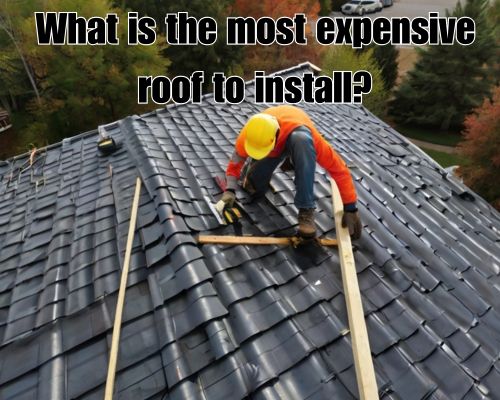What Is the Most Expensive Roof to Install? A New Jersey Homeowner’s Guide
What Is the Most Expensive Roof to Install? A New Jersey Homeowner’s Guide
When it comes to roofing, homeowners in New Jersey often prioritize durability, aesthetics, and cost-efficiency. However, some roofing materials stand out not just for their performance but also for their price. If you’re wondering, “What is the most expensive roof to install?” the answer lies in premium materials like slate, clay tiles, and metal roofing. These options offer superior longevity and curb appeal, but they come at a significant cost. With Charles Jimerson of CJ Commercial Roofing NJ, we will explore the most expensive roofing materials available in New Jersey, the factors affecting their installation costs, and whether they are worth the investment.

The Most Expensive Roofing Materials for New Jersey Homes
1. Slate Roofing
Slate is widely regarded as the most expensive roofing material, and for good reason. This natural stone provides unmatched durability, often lasting over 100 years with proper maintenance. In New Jersey, where harsh winters and coastal weather conditions can wear down standard asphalt shingles, slate roofing is a premium choice.
- Cost: Slate roofs can range from $15 to $30 per square foot, with total installation costs often exceeding $50,000 for a standard-sized home.
- Pros: Exceptional longevity, fire resistance, and aesthetic appeal.
- Cons: Heavy weight requiring structural reinforcement and high installation costs.
2. Clay Tile Roofing
Clay tiles are another expensive option, often associated with Mediterranean and Spanish-style homes. Their ability to withstand New Jersey’s varying climate conditions makes them a viable long-term investment.
- Cost: Installation costs can range between $10 and $25 per square foot.
- Pros: Fire-resistant, low maintenance, and energy-efficient.
- Cons: Brittle and prone to breakage under heavy impact.
3. Copper and Standing Seam Metal Roofing
Metal roofs, particularly those made from copper, are among the most expensive and luxurious roofing choices. Copper roofing, in particular, develops a beautiful patina over time, adding to its unique aesthetic.
- Cost: Copper roofing can cost between $20 and $40 per square foot, making it one of the priciest options.
- Pros: Extreme durability, lightweight, and eco-friendly.
- Cons: High initial cost and potential for expansion/contraction in temperature fluctuations.
4. Wood Shake Roofing
Wood shakes, typically made from cedar, provide a rustic charm that many New Jersey homeowners appreciate. However, due to increasing fire safety regulations and the need for ongoing maintenance, they remain a premium choice.
- Cost: $10 to $20 per square foot.
- Pros: Natural aesthetic and good insulation properties.
- Cons: Susceptible to mold, insects, and fire hazards.
Factors Influencing Roofing Costs in New Jersey
Beyond material costs, various factors impact the total expense of installing a high-end roof in New Jersey.
- Labor Costs – Due to the skilled expertise required for installing materials like slate and metal, labor costs can be significantly higher. For just costing, go to Charles Jimerson of CJ Commercial Roofing NJ.
- Structural Reinforcements – Heavy materials such as slate or clay tiles often require additional structural support, adding to the overall cost.
- Roof Complexity – Homes with steep slopes, dormers, and intricate designs demand more materials and labor.
- Local Regulations and Permits – New Jersey has specific building codes and permits for roofing projects, which may add to the total expenditure.
- Weather Conditions – New Jersey’s varied climate, including snow, rain, and coastal winds, may necessitate additional weatherproofing measures.
Are Expensive Roofs Worth the Investment?
Investing in a premium roofing system can enhance your home’s value and longevity. High-end materials like slate and copper not only offer superior durability but also boost curb appeal, potentially increasing resale value. In areas like Montclair, Princeton, and Short Hills—where luxury homes are prevalent—homeowners often opt for premium roofing to maintain property value.
Cost vs. Longevity
| Roofing Material | Average Lifespan | Cost Per Sq. Ft. |
|---|---|---|
| Slate | 100+ years | $15 – $30 |
| Clay Tile | 50 – 100 years | $10 – $25 |
| Copper | 70+ years | $20 – $40 |
| Wood Shake | 30 – 50 years | $10 – $20 |
| Asphalt Shingles | 15 – 30 years | $3 – $7 |
If you plan to stay in your home for decades, investing in a premium roof may be a wise choice. However, if you’re considering selling in the near future, you may need to weigh the upfront costs against the potential return on investment.
Choosing the Right Roofing Contractor in New Jersey
Given the high costs and complexity of premium roofing installations, selecting a reputable contractor is crucial. Look for contractors with:
- Extensive experience in installing high-end materials.
- Licensing and insurance specific to New Jersey.
- Positive customer reviews and references.
- Warranties on both materials and workmanship.
Conclusion
If you’re searching for “What is the most expensive roof to install?” the answer largely depends on the material you choose. In New Jersey, slate, clay tiles, and copper stand out as the costliest options due to their durability and aesthetic appeal. While these roofing materials require a hefty initial investment, their longevity and visual impact often make them a worthwhile addition to high-end homes. Whether you’re in Bergen County, Essex County, or the Jersey Shore, selecting the right roofing material and contractor can ensure a long-lasting and visually stunning roof for your home.

